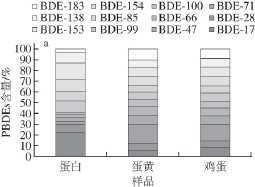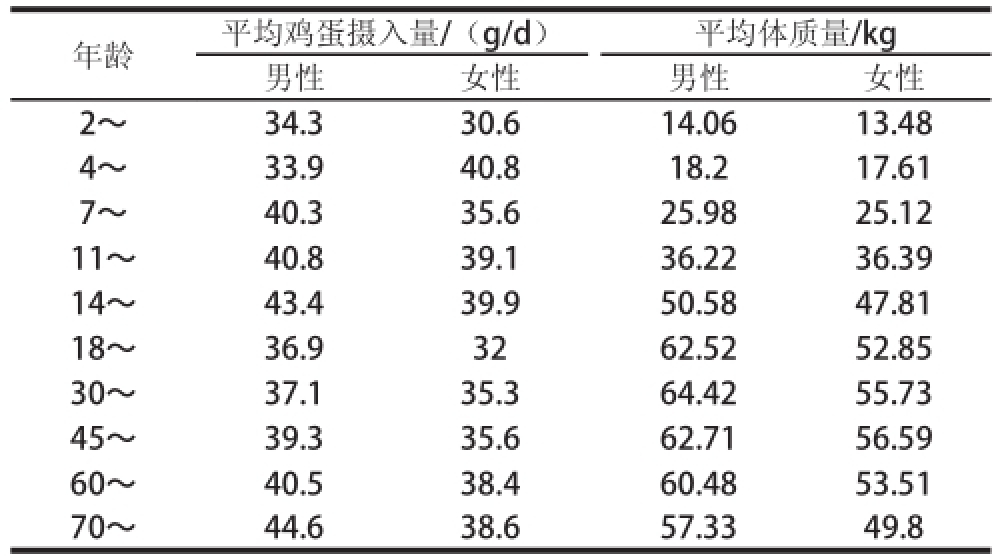李敏洁 1,2,张 鹏 1,金 芬 1,*,乌日娜 1,邵 华 1,金 茂俊 1,王 静 1
(1.农业部农产品质量安全重点实验室,中国农业科学院农业质量标准与检测技术研究所,北京 100081;2.安 阳市疾病预防控制中心,河南 安阳 455000)
摘 要:为揭示北京地区鸡蛋中多溴联苯醚(polybrominated diphenyl ethers,PBDEs)及其甲氧基衍生物(methoxylated polybrominated diphenyl ethers,MeO-PBDEs)的污染特征,本实验利用气相色谱-负化学电离源-质谱分析了北京地区65 个鸡蛋样品中12 种PBDEs及5 种MeO-PBDEs的污染水平与组成特征。结果表明,鸡蛋中∑PBDEs和∑MeO-PBDEs的含量水平分别为ND(未检出)~2.21 ☒g/kg(以全蛋湿质量计,下同)和ND~0.89 ☒g/kg,检出率分别为15.38%和4.62%,与国内外相关研究相比处于较低水平。PBDEs中BDE-71的检出质量浓度较高,MeO-PBDEs以MeO-85为主要检出成分,其中蛋黄中的PBDEs和MeO-PBDEs的检出种类数量及含量均高于蛋白。通过膳食风险评估,表明北京市售鸡蛋产品中PBDEs的污染水平和膳食暴露均在可接受的范围内。
关键词:鸡蛋;多溴联苯醚及甲氧基衍生物;污染水平;膳食风险评估
李敏洁, 张鹏, 金芬, 等. 北京地区鸡蛋中多溴联苯醚及甲氧基衍生物污染特征及其膳食风险评估[J]. 食品科学, 2016,37(15): 227-231. DOI:10.7506/spkx1002-6630-201615038. http://www.spkx.net.cn
LI Minjie, ZHANG Peng, JIN Fen, et al. Pollution level and dietary risk assessment of polybrominated diphenyl ethers and methoxylated polybrominated diphenyl ethers in egg samples in Beijing[J]. Food Science, 2016, 37(15): 227-231. (in Chinese with English abstract) DOI:10.7506/spkx1002-6630-201615038. http://www.spkx.net.cn
多溴联苯醚(polybrominated diphenyl ethers,PBDEs)是目前广泛用于塑料、电子以及涂料等产品中的溴代阻燃剂。近年来,因其对环境及人类健康的影响而受到广泛关注。2009年,商业化的五溴联苯醚及八溴联苯醚被列为全球控制和消减的持久性有机污染物(persistent organic pollutants,POPs),现有研究表明PBDEs具有神经毒性、生殖毒性、内分泌毒性和肝脏毒性,对人类身体健康具有潜在危害 [1-4]。PBDEs在生物体内的代谢产物甲氧基代谢物(methoxylated polybrominated diphenyl ethers,MeO-PBDEs) [5-6]因可能具有更高的毒性也逐渐受到关注 [7-8]。有研究表明,人体血液中MeO-PBDEs的含量高于PBDEs [9],然而目前关于生物样品中的PBDEs和MeO-PBDEs同时测定、污染特征及风险评估等方面的研究还较少。
动物性食品是人们暴露PBDEs的重要途径之一 [10],水产品,畜产品等均有PBDEs检出的报道。鸡蛋可提供丰富的蛋白质、维生素和矿物质,因此在人类膳食营养结构中占据重要的地位。PBDEs的辛醇/水分配系数(octanol-water partition coefficients,logKow)约为4.5~10.0,具有脂溶性,因此富含脂质的动物性食品是人们暴露PBDEs的重要途径之一。目前,国内关于鸡蛋中多溴联苯醚污染水平的调查,主要集中于电子垃圾污染区,如广东清远、贵屿,浙江台州、临安等 [11-12]污染区的样品,不能代表一般地区的暴露水平,且对鸡蛋中PBDEs衍生物的研究较少。因此,本实验对北京市市售鸡蛋中的PBDEs和MeO-PBDEs污染水平进行了调查,探讨了鸡蛋中PBDEs和MeO-PBDEs的污染特征,并对其膳食风险进行了评估。
1.1 材料与试剂
2014年分别从北京超市发、家乐福等超市采集不同品牌和来源的鸡蛋,包括柴鸡蛋、鲜鸡蛋和有机鸡蛋等共计65 个样品。
12 种多溴联苯醚混合标准品(BDE-17、BDE-28、BDE-47、BDE-66、BDE-71、BDE-85、BDE-99、BDE-100、BDE-138、BDE-153、BDE-154、BDE-183)、5 种甲氧基多溴联苯醚(2’-MeO-BDE-28、6-MeO-BDE-47、2’-MeO-BDE-68、6-MeO-BDE-85、6-MeO-BDE-137),目标物纯度均≥98.5% 美国Accu standard公司;二氯甲烷、正己烷(色谱级) 美国Fisher公司;乙酸乙酯、环己烷、乙腈(农残级) 美国Honeywell公司;十八烷基键合硅胶(octadecyl bonded silica,C 18)吸附剂 天津博纳艾杰尔公司;三硅酸二镁(即弗罗里硅土(Florisil)) 美国Sigma公司。
1.2 仪器与设备
Varian-300气相色谱-质谱/质谱仪 美国瓦里安公司;ASE 300加速溶剂萃取仪 美国戴安公司;NE-1101旋转蒸发仪 日本EYELA公司;FD-1A-50冷冻干燥机 上海博医康实验仪器有限公司;J2凝胶渗透色谱净化系统 美国AccuPrep MPStm公司;KQ5200DB型数控超声波清洗器 中国昆山市超声仪器有限公司;台式高速冷冻离心机 德国Biofuge Stratos公司;Milli-Q超纯水器 美国Millipore公司。
1.3 方法
1.3.1 样品的提取和净化
将鸡蛋进行蛋白和蛋黄分离后采用冷冻干燥将样品冻干成粉。称取1.0 g(精确至0.01 g)冻干蛋白粉或蛋黄粉,加入1.0 g(精确至0.01 g)硅藻土混匀后装入34 mL的加速溶剂萃取(accelerated solvent extraction,ASE)池中。正己烷和二氯甲烷(1∶1,V/V)混合溶剂,在100 ℃、10.34 MPa条件下,预热5 min,静态提取10 min,60%萃取池体溶剂快速冲洗样品,氮气吹扫90 s等条件以加速溶剂萃取,收集全部萃取液置于收集瓶。将萃取液转入100 mL旋转蒸发瓶中,30 ℃减压旋转蒸发浓缩至近干。使用乙酸乙酯和环己烷(1∶1,V/V)混合溶剂,定容10 mL,过0.45 μm尼龙膜后进行凝胶渗透色谱(gel permeation chromatography,GPC)净化。
GPC采用50 g Bio-Beads S-X3(400 mm×30 mm)聚苯乙烯树脂凝胶色谱柱,流动相为乙酸乙酯-环己烷(1∶1,V/V),流速4.7 mL/min。收集18~30 min的组分于100 mL旋转蒸发瓶中,在30 ℃、120 r/min条件下旋转蒸发至近干,用乙腈润洗3 次转入K-D浓缩管并旋蒸至1 mL以下,用乙腈定容至1 mL。用玻璃吸管将其转入装有100 mg C 18分散固相萃取吸附剂的10 mL玻璃离心管中,高速涡旋1 min后,在4 ℃、3 000 r/min条件下离心5 min,上清液过0.22 μm有机相滤膜后,用气相色谱-负化学电离源-质谱(gas chromatography-negative chemical ionization/ mass spectrometry,GC-NCI/MS)法进行测定。
1.3.2 测定方法
采用GC-NCI/MS进行分析测定 [13]。气相色谱条件:DB-5 MS UI毛细管柱(30 m×0.25 mm,0.25 μm);程序升温:初始温度180 ℃,保持2 min;以15 ℃/min升至205 ℃,保持2 min;以3 ℃/min升至251 ℃,保持1 min;以5 ℃/min升至310 ℃,保持10 min,共计41.83 min;载气(He)恒流,柱流量1.0 mL/min;进样口温度280 ℃;不分流进样,进样体积:1 μL。质谱条件:离子源温度280 ℃;负化学电离源(NCI);电子能量70 eV;溶剂延迟时间6.00 min;反应气甲烷,压力为0.666 kPa;选择离子监测(selected ion monitoring,SIM)。12 种PBDEs和5 种MeO-PBDEs的监测离子为79.0和80.9,选择79.0做定量离子。
1.3.3 质量保证与控制(QA/QC)
本实验采用玻璃器皿,实验器材在使用前用水和甲醇清洗。为对实验过程进行质量控制,每批样品(15个)均带一个流程空白样品,用1 mL正己烷替代样品,后续操作按照1.3.1节处理进行提取净化,供GC-NCI/MS分析。
1.4 膳食风险评估
目前,国际上没有一个统一的关于PBDEs和MeO-PBDEs的每日耐受摄入量(tolerable daily intake,TDI)的标准,本实验采用简单分布模型方法,计算了鸡蛋中PBDEs和MeO-PBDEs的膳食摄入量(daily intake,DI),计算公式如下:
式中:DI为PBDEs和MeO-PBDEs的膳食摄入量;c为鸡蛋中PBDEs和MeO-PBDEs的含量/(ng/kg);IR j为不同人群对鸡蛋的平均摄入量/(g/d);EF为暴露频率(exposure frequency,365 d/a);ED为人群暴露周期(exposure duration,30 a);BW j为不同人群体质量;AT为日膳食摄入量平均预估时间(daily intake estimates,averaging time,10 950 h)。j表示不同的年龄组。
风险评估采用暴露限值(margin of exposure,MOE)的方法 [14]进行测评。欧洲食品安全局(European Food Safety Authority,EFSA)以神经发育毒性作为评价终点,BDE-47、BDE-99、BDE-153引起10%不良反应的95%统计学可信区间下限值(benchmark dose lower confidence limit,BMDL 10)分别为172、4、9.6 ng/kg(以体质量计)。按下式计算暴露限值。
2.1 鸡蛋中PBDEs和MeO-PBDEs的污染水平和特征
由表1可见,鸡蛋中PBDEs和MeO-PBDEs的检出率分别为15.38%和4.62%,其中∑PBDEs的含量为ND~2.21g/kg(以全蛋湿质量计,下同;ND表示未检出),高于∑MeO-PBDEs的含量(ND~0.89 g/kg)。鸡蛋中∑PBDEs的平均含量为0.070 g/kg,低于我国电子污染区鸡蛋中∑PBDEs的平均含量(1.23~8.21 ☒g/kg) [11],远低于广东清远鸡蛋中的平均含量(640~14 100 ☒g/kg fw(fat weight,以脂肪质量计)) [12],略高于台湾地区鸡蛋中的∑PBDEs含量(0.55 ☒g/kg fw) [15]和全国平均水平(0.056 ☒g/kg ww(以全蛋湿质量计)) [16]。与国外相比,∑PBDEs的含量高于比利时鸡蛋中的污染水平(3.5~7.77 ☒g/kg fw) [17],与荷兰相近(0.071 ☒g/kg ww) [18],高于瑞典水平(0.026 ☒g/kg) [19]。
表1 蛋白蛋黄中检出∑PBDEs和∑MeO-PBDEs的含量(n==6655)
Table 1 Concentrations of ∑PBDEs and ∑MeO-PBDEs in egg samples (les n = 65) 65 g/kg

注:LOQ. 定量限;ND. 未检出。
物质项目∑PBDEs∑MeO-PBDEs蛋白最大值0.36ND最小值<LOQ [13]ND平均值0.016ND检出率7.69%相对标准偏差2.79蛋黄最大值6.582.66最小值<LOQ<LOQ平均值0.180.089检出率9.23%4.62%相对标准偏差4.679.32最大值2.210.89最小值<LOQ<LOQ平均值0.0700.033检出率15.38%4.62%相对标准偏差3.171.33全蛋
此外,在对同一个鸡蛋进行蛋白和蛋黄分离测定时,发现蛋白和蛋黄中的PBDEs和MeO-PBDEs的污染分布也有所不同。在鸡蛋蛋白中,PBDEs的检出率为7.69%,∑PBDEs含量范围为ND~0.36 g/kg ww;MeOPBDEs则未检出。而在鸡蛋蛋黄中,PBDEs的检出率为9.23%,∑PBDEs含量范围为ND~6.58 g/kg ww,与加拿大水平相当(0.005~5.85 ☒g/kg ww) [18]。蛋黄中∑MeO-PBDEs的检出率为4.62%,含量范围为ND~2.66 g/kg ww。蛋黄中PBDEs和MeO-PBDEs的检出种类及含量水平均高于蛋白,这可能与PBDEs的logKow较高(4.5~10.0),蛋黄中的脂肪含量远高于蛋白中的脂肪含量有关。虽然目前尚无其他鸡蛋中MeO-PBDEs污染水平的报道,但与食用鱼油中的MeO-PBDEs的平均含量水平相比,低于食用鱼油中的MeO-PBDEs的平均含量水平(6.2 g/kg) [21],但是部分检出含量较高的样品仍然需要引起注意。


图1 蛋白、蛋黄和鸡蛋中PBDEs(a)和MeO-PBDEs(bb)的平均百分含量
Fig. 1 The distribution of PBDEs (a) and MeO-PBDEs (b) in egg white,egg yolk and whole egg
鸡蛋中BDE-17、154、153、138的检出率较高,由图1a可知,BDE-71的检出含量较高,其次为BDE-183、154、153、138。而蛋白中检出率和检出含量最高的均为BDE-17,蛋黄中检出率较高的为BDE-154和BDE-153,检出含量较高的为BDE-71,其次为BDE-183、154、153、138。与PBDEs相比,蛋白中未检出MeO-PBDEs(图1b),蛋黄及鸡蛋中的MeO-85的检出率及检出含量较高。
2.2 PBDEs和MeO-PBDEs的膳食暴露风险评估
Lunder等 [22]研究发现婴幼儿血液中的PBDEs要高于其母体。因此本实验将北京人口按不同年龄和性别分为8 组。我国不同年龄段人均体质量参照《中国居民营养与健康状况调查报告》,鸡蛋的膳食消费量参考《我国居民营养与健康状况调查报告》中大城市不同性别居民动物性食物摄入量 [23],该数据是在2002年我国膳食摄入量调查的基础上进行统计分析(表2)。
表2 我国大城市不同性别年龄居民鸡蛋摄入量和体质量
[23]
Table 2 Egg intake and average body weight for each age group in Chinese metropolises
[23]

年龄平均鸡蛋摄入量/(g/d)平均体质量/kg男性女性男性女性2~34.330.614.0613.48 4~33.940.818.217.61 7~40.335.625.9825.12 11~40.839.136.2236.39 14~43.439.950.5847.81 18~36.93262.5252.85 30~37.135.364.4255.73 45~39.335.662.7156.59 60~40.538.460.4853.51 70~44.638.657.3349.8
2.2.1 膳食摄入量
由表3可知,婴幼儿的每日摄入P B D E s和MeO-PBDEs的量大于其他年龄阶段。表3中北京市各年龄组的男性及女性通过鸡蛋摄入的∑MeO-PBDEs的DI平均值为0.02~0.08 ng/(kg·d)(以体质量计),少于MeO-PBDEs的摄入量。而通过鱼油摄入MeO-PBDEs的含量要高于PBDEs的含量,与本实验结果有差异 [21]。
表3 北京不同性别年龄居民通过鸡蛋摄入PBDEs和MeO-PBDEs的含量
Table 3 Average DI levels of PBDEs and MeO-PBDEs through egg ingestion for male and female in each age group in Beijing ng/(kg·d)

年龄PBDEs含量MeO-PBDEs含量男女男女2~0.17 0.16 0.08 0.08 4~0.13 0.16 0.06 0.08 7~0.11 0.10 0.05 0.05 11~0.08 0.07 0.04 0.04 14~0.06 0.06 0.03 0.03 18~0.04 0.04 0.02 0.02 30~0.04 0.04 0.02 0.02 45~0.04 0.04 0.02 0.02 60~0.05 0.05 0.02 0.02 70~0.05 0.05 0.03 0.03
2.2.2 PBDEs的膳食安全评估
根据卫生部2002年的《中国居民营养与健康状况调查报告》 [23],我国城市居民鸡蛋摄入量为33.2 g/d,标准体质量63 kg。北京居民鸡蛋中BDE-47、BDE-99和BDE-153的平均摄入量为0.002 7、0.003 0、0.003 4 ng/(kg·d)(以体质量计)。EFSA基于神经发育毒性作为评价终点,推荐BDE-47、BDE-99和BDE-153 BMDL 10分别为172、4、9.6 ng/(kg·d)(以体质量计)。根据公式(2)计算得到BDE-47、BDE-99和BDE-153的MOE分别为62 752,1 328和2 854。根据EFSA的建议,MOE大于2.5,表明不需要对该类物质进行健康关注。因此,北京地区居民摄入鸡蛋的PBDEs健康风险可以忽略。
在北京地区的65 个鸡蛋样品中,12 种PBDEs和5 种MeO-PBDEs均有检出,检出率分别为15.38%和4.62%,其中BDE-71的检出含量较高,BDE-17、154、153、138的检出率较高,蛋白中检出率和检出含量最高的均为BDE-17,蛋黄中检出含量较高的为BDE-71,检出率较高的为BDE-154和BDE-153。与国内外研究相比,北京地区鸡蛋中PBDEs及MeO-PBDEs含量处于较低水平。MeO-PBDEs在蛋白中未检出,蛋黄及鸡蛋中的MeO-85的检出率及检出含量较高。通过PBDEs的膳食安全评估,北京地区居民摄入鸡蛋的PBDEs的健康风险可以忽略。
参考文献:
[1] LEE H J, KIM G B, LEE R F. Genotoxicity and development effects of brominated flame retardant PBDEs and UV-exposed PBDEs on grass shrimp (Palaemonetes pugio) embryo[J]. Marine Pollution Bulletin,2012, 64(12): 2892-2895. DOI:10.1016/j.marpolbul.2012.08.010.
[2] YANG Weihua, WEI Si, LIU Hongling, et al. Insights into the structural and conformational requirements of polybrominated diphenyl ethers and metabolites as potential estrogens based on molecular docking[J]. Chemosphere, 2011, 84(3): 328-335. DOI:10.1016/j.chemosphere.2011.04.010.
[3] TALSNESS C E, KURIYAMA S N, STERNER K, et al. In utero and lactational exposures to low doses of polybrominated diphenyl ether-47 alter the reproductives system and thyroid gland of female rat offspring[J]. Environmental Health Perspectives, 2008, 116(3): 308-314. DOI:10.1289/e hp.10536.
[4] CROSSE J D, SHORE R F, JONES K C, et al. Key factors affecting liver PBDE concentrations in sparrowhawks ( Accipiter nisus)[J]. Environmental Pollution, 2013, 177: 171-176. DOI:10.1016/ j.envpol.2013.02.006.
[5] ERRATICO C A, SZEITZ A, BANDIERA S M. Validation of a novel in vitro assay using ultra performance liquid chromatographymass spectrometry (UPLC/MS) to detect and quantify hydroxylated metabol ites of BDE-99 in rat liver microsomes[J]. Journal of Chromatography B, 2010, 878(19): 1562-1568. DOI:10.1016/ j.jchromb.2010.04.014.
[6] SUN Jianteng, LIU Jiyan, LIU Yanwei, et al. Hydroxylated and methoxylated polybrominated diphenyl ethers in mollusks from Chinese coastal areas[J]. Chemosphere, 2013, 92(3): 322-328. DOI:10.1016/j.chemosphere.2013.03.042.
[7] van BOXTEL A L, KAMSTRA J H, CENIJN P H, e t al. Microarray analysis reveals a mechanism of phenolic polybrominated diphenylether toxicity in zebrafish[J]. Environmental Science & Technology, 2008, 42(5): 1773-1779. DOI:10.1021/es0720863.
[8] SONG R F, DUARTE T L, ALMEIDA G M, et al. Cytotoxicity and gene expression profiling of two hydroxylated polybrominated diphenyl ethers in human H295R adrenocortical carcinoma cells[J]. Toxicology Letters,2009, 185(1): 23-31. DOI:10.1016/j.toxlet.2008.11.011.
[9] WANG Hongsheng, CHEN Zhuojia, HO K L, et al. Hydroxylated and methoxylated polybrominated diphenyl ethers in blood plasma of humans in Hong Kong[J]. Environment International, 2012, 47: 66-72. DOI:10.1016/j.envint.2012.06.004.
[10] NI Kun, LU Yonglong, WANG Tieyu, et al. A review of human exposure to polybrominated diphenyl ethers (PBDEs) in China[J]. International Journal of Hygiene and Environmental Health, 2013,216(6): 607-623. DOI:10.1016/j.ijheh.2013.02.002.
[11] CHAN J K, MAN Y B, WU S C, et al. Dietary intake of PBDEs of residents at two major electronic waste recycling sites in China[J]. Science of the Total Environment, 2013, 463/464: 1138-1146. DOI:10.1016/j.scitotenv.2012.06.093.
[12] ZHENG Xiaobo, WU Jiangping, LUO Xiaojun, et al. Halogenated flame retardants in home-produced eggs from an electronic waste recycling region in South China: levels, composition profiles, and human dietary exposure assessment[J]. Environment International,2012, 45: 122-128. DOI:10.1016/j.envint.2012.04.006.
[13] 李敏洁, 金芬, 杨莉莉, 等. 凝胶渗透色谱-分散固相萃取法同时测定鸡蛋中多溴联苯醚及其衍生物、四溴双酚A和六溴环十二烷[J]. 分析化学, 2014 (9): 1288-1294. DOI:10.11895/ j.issn.0253-3820.140233.
[14] EFSA. Scientific opinion on polybrominated diphenyl ethers (PBDEs)in food[J]. EFSA Journal, 2011, 9(5). DOI:10.2903/j.efsa.2011.2156.
[15] CHEN Meilien, WANG Lee, CHI Yangkai, et al. Polybrominated diphenyl ethers in foodstuffs from Taiwan: level a nd human dietary exposure assessment[J]. Science of the Total Environment, 2012, 431: 183-187. DOI:10.1016/j.scitotenv.2012.05.046.
[16] ZHANG Lei, LI Jingguang, ZHAO Yunfeng, et al. Polybrominated diphenyl ethers (PBDEs) and indicator polychlorinated biphenyls (PCBs)in foods from China: levels, dietary intake, and risk assessment[J]. Environmental Science & Technology, 2013, 61: 6544-6551. DOI:10.1016/j.chemosphere.2010.12.045.
[17] COVACI A, ROOSENS L, DIRTU A C, et al. Brominated flame retardants in Belgian home-produced eggs: levels and contamination sources[J]. Science of the Total Environment, 2009, 407(15): 4387-4396. DOI:10.1016/j.scitotenv.2008.09.057.
[18] BAKKER M I, de WINTER-SORKINA R, de MUL A, et al. Dietary intake and risk evaluation of polybrominated diphenyl ethers in the Netherlands[J]. Molecular Nutrition & Food Research, 2008, 52: 204-216. DOI:10.1002/mnfr.200700112.
[19] T☒RNKVIST A, GLYNN A, AUNE M, et al. PCDD/F, PCB, PBDE,HBCD and chlorinated pesticides in a Swedish market basket from 2005 - levels and dietary intake estimations[J]. Chemosphere, 2011,83(2): 193-199. DOI:10.1016/j.chemosphere.2010.12.042.
[20] RAWN D F, VOORSPOELS S, VETTER W, et al. Anthropogenic and naturally occurring organobrominated compounds in fish oil dietary supplements[J]. Environmental Science & Technology, 2007, 41 (15): 5237-5244. DOI:10.1021/es070239g.
[22] LUNDER S, HOVANDER L, ATHANASSIADIS I, et al. Significantly higher polybrominated diphenyl ether levels in young U.S. children than in their mothers[J]. Environmental Science & Technology, 2010, 44 (13): 5256-5262. DOI:10.1021/es1009357.
[23] 杨晓光, 翟凤英. 中国居民营养与健康状况调查报告之三. 2002年膳食与营养素摄入状况[M]. 北京: 人民卫生出版社, 2006: 51-52.
Pollution Level and Dietary Risk Assessment of Polybrominated Diphenyl Ethers and Methoxylated Polybrominated Diphenyl Ethers in Egg Samples in Beijing
LI Minjie
1,2, ZHANG Peng
1, JIN Fen
1,*, WU Rina
1, SHAO Hua
1, JIN Maojun
1, WANG Jing
1
(1. Key Laboratory of Agro-product Quality and Safety of Ministry of Agriculture, Institute of Quality Standards & Testing Technology for Agro-products, Chinese Academy of Agricultural Sciences, Beijing 100081, China;2. Anyang City Center for Disease Control and Prevention, Anyang 455000, China)
Abstract:The pollution levels and composition characteristics of 12 polybrominated diphenyl ethers (PBDEs) and 5 methoxylated polybrominated diphenyl ethers (MeO-PBDEs) in 65 egg samples from Beijing markets were examined by gas chromatography-negative chemical ionization mass spectrometry (GC-NCI/MS) to explore their pollution characteristics. The level of total PBDEs detected in egg samples was 2.21 μg/kg, and the level of total MeO-PBDEs were 0.89 μg/kg, which were lower than other relevant studies in China and abroad. The relevance ratio of PBDEs and MeO-PBDEs were 15.38% and 4.62% and these pollutants were dominated by BDE-71 and MeO-85. The kinds and levels of analytes in egg yolk were higher than those in egg white. Pollution level and dietary risk assessment of PBDEs in eggs showed acceptable levels of PBDEs in eggs from Beijing supermarkets.
Key words:egg; polybrominated diphenyl ethers (PBDEs) and methoxylated polybrominated diphenyl ethers (MeO-PBDEs);pollution level; dietary risk assessment
DOI:10.7506/spkx1002-6630-201615038
中图分类号:O657.63
文献标志码:A
文章编号:1002-6630(2016)15-0227-05
收稿日期:2015-09-25
基金项目:“十二五”国家科技支撑计划项目(2012BAD29B03)
作者简介:李敏洁(1989—),女,硕士研究生,研究方向为食品质量与安全。E-mail:liminjie_2012@163.com
*通信作者:金芬(1978—),女,研究员,博士研究生,研究方向为农产品质量安全与检测技术。E-mail:jinfenbj@163.com
引文格式: